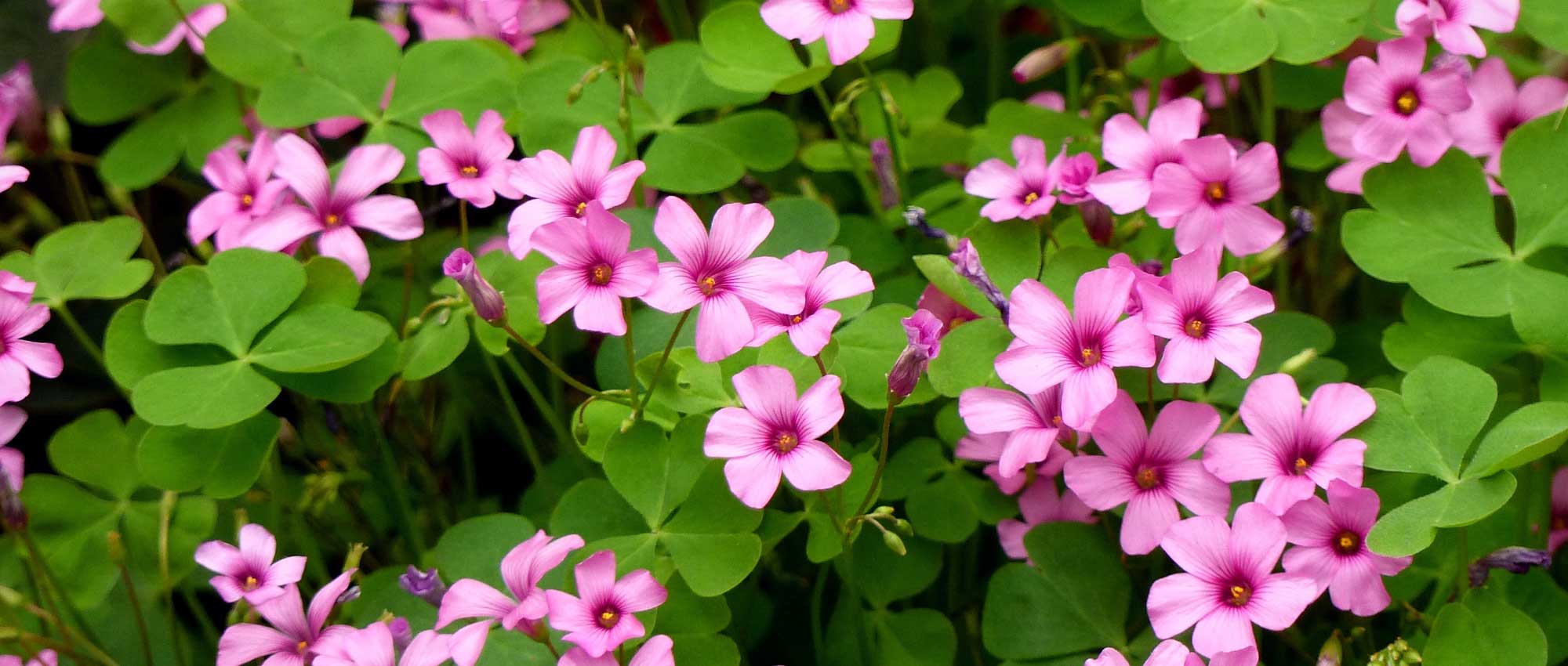
Oxalis: planting, growing and caring for
Contents
Oxalis in a nutshell
- Oxalis offer very decorative foliage, resembling clover, which can be green or purple
- Appreciated for their star-shaped flowering, often in bright, luminous shades
- They are creeping plants, spreading rapidly and making good groundcovers, but can also be grown in pots, troughs or planters
- They are fairly easy to grow and propagate readily
- They charm with delicate foliage and flowers!
A word from our Expert
Oxalis is a small groundcover plant that spreads rapidly and resembles clover. Their leaves usually have three leaflets, but in some species they have four. Oxalis plants also produce pretty, small star-shaped flowers, often white, pink or yellow, sometimes red.
Oxalis can resemble weeds that people try to remove rather than to grow! Some, such as Oxalis corniculata and Oxalis acetosella, are widespread adventive weeds in gardens in France. However, there are also very decorative, fairly non-invasive species. Some of the varieties discussed on this page are frost-tender and will struggle to survive winter without protection.
Oxalis triangularis is a distinctive, very graphic, modern-looking plant. It is prized for its deep, dark purple colour and its triangular leaflets. Oxalis deppei, by contrast, has the true look of a four-leaf clover, but with bicoloured leaflets, green on the outside and brown in the centre. Other Oxalis are impressive for their flowering, such as Oxalis versicolor, which produces stunning white-and-red flowers that are very striking!
Oxalis can easily be grown in pots or planters. This makes it possible to bring them under cover when temperatures drop. Some species, like Oxalis triangularis, even adapt very well to indoor growing.
Description and botany
Botanical data
- Latin name Oxalis sp.
- Family Oxalidaceae
- Common name oxalis, oxalide, 'false shamrock'
- Flowering depending on variety, between spring and autumn.
- Height between 5 and 30 cm
- Exposure sun or partial shade
- Soil type humus-bearing, light, free-draining, cool in summer
- Hardiness between 0 and u201310 u00b0C
Oxalis are small herbaceous plants, often bulbous, with a spreading habit. They are decorative for their foliage, which resembles that of clovers, and for their star-shaped flowering. Oxalis comprises around 500 species, which can be annual or perennial. They have a very wide worldwide distribution, but greatest diversity occurs in South America and South Africa. Eight species occur in the wild in France, including Oxalis acetosella and Oxalis corniculata, which are found across most of metropolitan France. In the wild, oxalis grow in open habitats or woodland understorey, which explains why some prefer full sun while others favour shade.
Oxalis are not always very hardy. Some tolerate down to -10 °C, but others suffer as temperatures approach 0 °C and need to be brought under cover for winter. Oxalis triangularis, for example, is commonly grown as a houseplant and can spend the whole year in an apartment or house.
The name Oxalis comes from the Greek oxys, meaning ‘acid, sour’, a reference to the tangy taste of its leaves. In French they are sometimes called oxalides, or ‘false shamrocks’. Oxalis acetosella is also called ‘cuckoo’s bread’, or ‘wood sorrel’.
Oxalis gave their name to the family Oxalidaceae, of which they represent the majority of species (500 out of 600). Apart from the resemblance of their foliage, oxalis have nothing to do with clovers (Trifolium sp.), which belong to the Fabaceae family. Their flowers are very different.
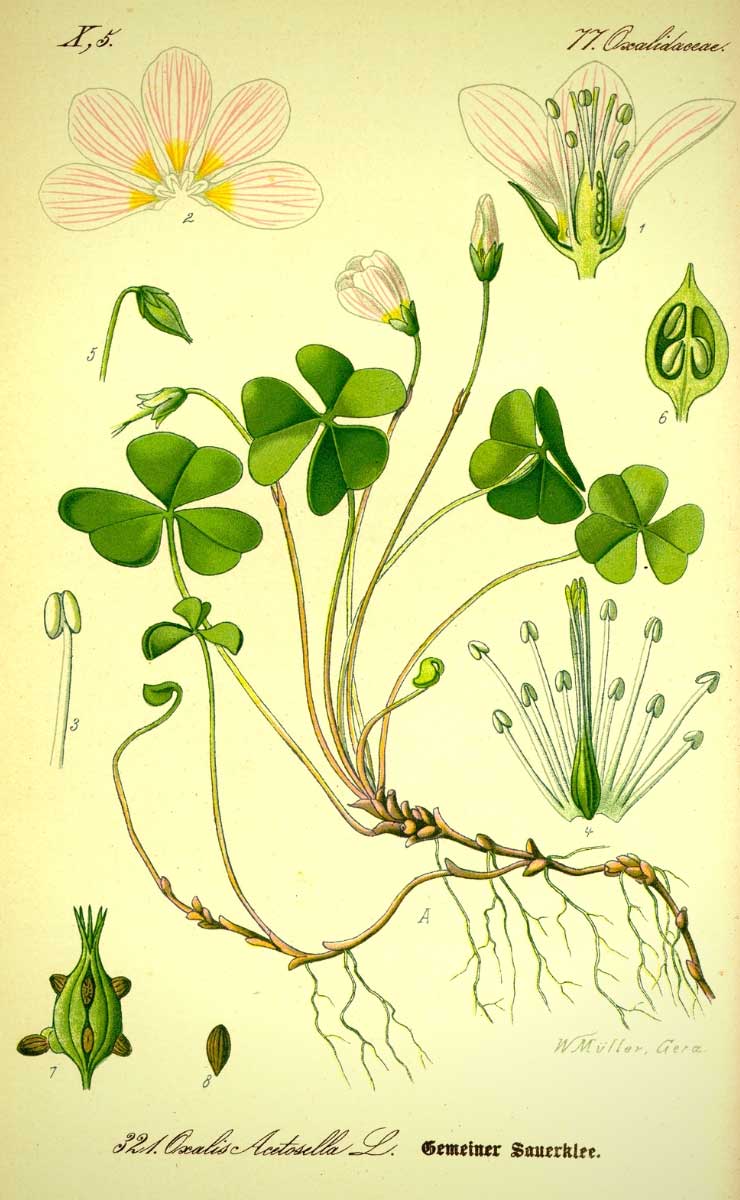
Oxalis acetosella: botanical illustration
Oxalis are sometimes regarded as weeds, and some can be truly invasive… But this mainly concerns Oxalis acetosella and O. corniculata, which grow wild in France and can be difficult to eliminate.
Oxalis contain oxalic acid, which gives their leaves a tart flavour, like sorrel or rhubarb, but makes them toxic in large quantities.
Oxalis are low, creeping plants that can be used as groundcover. They reach between 5 and 30 cm in height and spread quickly in width. Oxalis hedysaroides is an exception, as it can reach up to 1 m in height!
Oxalis triangularis has long, very thin petioles that give it an airy appearance. This characteristic, combined with its triangular, purple leaflets, creates a very graphic, modern look, making it a popular houseplant.
Depending on variety, flowering occurs between spring (May–June) and autumn… with the exception of Oxalis versicolor, which has an inverted cycle and blooms in winter. In general, Oxalis flowering lasts for a long time.
Flowers are usually white, pink or yellow, sometimes red or mauve. Flowering is bright, often in clear, vivid tones. Centre of the corolla is often shaded, either yellow or darker than the rest of the petals. Flowering of Oxalis versicolor is quite striking, with bicoloured petals, white and red. One might think it is a horticultural cultivar selected for its unusual flowers, but it is indeed a botanical species found in the wild. In Oxalis hedysaroides, the yellow flowers stand out beautifully against the dark purple foliage.
Oxalis flowers can be solitary or grouped in umbels. They are borne on long, upright peduncles that are fairly flexible. Flowering is star-shaped, very simple, made of five petals fused into a tube at the base. They are surrounded by five free sepals. Flowers are regular, with radial symmetry, and may be cup-shaped or funnel-shaped. Corolla tube is sometimes long and narrow, flaring into a funnel, as in Oxalis versicolor. Flowers also have ten stamens (five long and five short) bearing pollen.
Flowers are sensitive to light: they open fully in sun and close in the evening or when weather is overcast. More generally, oxalis need a bright position to produce generous, abundant flowering.

Flowering of Oxalis tetraphylla (photo Wildfeuer), Oxalis versicolor (photo Nzfauna) and Oxalis triangularis ‘Atropurpurea (photo Nekonomania)
Oxalis leaves closely resemble those of clovers. This is one reason species with four leaflets are popular – playing on the idea that four-leaf clovers bring luck.
Leaves often have a nice light green tint. They can also be purple, as in Oxalis triangularis… or bicoloured, as in Oxalis deppei, green on outer side of leaflets and brown at centre, with a strong contrast. Oxalis adenophylla has bluish-grey leaves.
In general, leaves are composed of three heart-shaped or triangular leaflets. They are often broad but can also be very narrow, almost linear (Oxalis versicolor). In Oxalis triangularis, leaflets are truly triangular, with a geometric shape, whereas edges are much more rounded in other oxalis.
When they have four leaflets, oxalis very much resemble the four-leaf clover! Other species have leaves composed of many leaflets (up to around twenty), as in Oxalis adenophylla. Each time, all leaflets are attached at centre at the same point; so when numerous they give the whole leaf a rounded shape. Some oxalis have exceptional, highly divided foliage, like Oxalis palmifrons, creating a palmate effect.
In most species, foliage folds at night or when weather is overcast, and unfolds by day (nyctinastic movements). The plant thus reacts to light. One could almost say the plant ‘sleeps’ at night, entering rest by folding its foliage and flowers!

Foliage of Oxalis tetraphylla (photo Wouter Hagens), Oxalis adenophylla and Oxalis triangularis ‘Atropurpurea’
Oxalis versicolor has the peculiarity of doing the opposite of many plants: it flowers in winter and enters dormancy in summer.
Oxalis generally have bulbs, but can also form rhizomes or tubercles. The oca of Peru (Oxalis tuberosa), for example, produces an edible tubercle. Some oxalis can spread very quickly by producing new bulblets alongside the original bulbs.
After flowering, oxalis produce capsules, thin and elongated, containing the seeds. These are expelled, ejected when the capsule opens.
Main Oxalis varieties
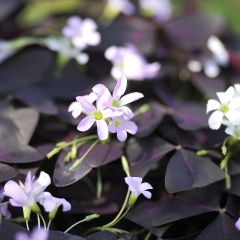
Oxalis triangularis
- Flowering time August to October
- Height at maturity 20 cm
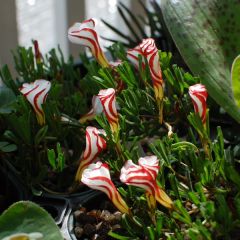
Oxalis versicolor
- Height at maturity 10 cm

Oxalis deppei
- Flowering time August, September
- Height at maturity 20 cm

Oxalis triangularis subsp. papilionacea Atropurpurea
- Flowering time July to December
- Height at maturity 15 cm
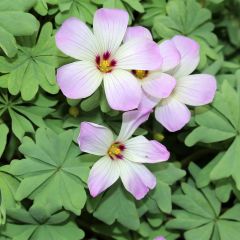
Oxalis adenophylla
- Flowering time July, August
- Height at maturity 10 cm
Discover other Oxalis
View all →Available in 1 sizes
Available in 1 sizes
Available in 1 sizes
Available in 0 sizes
Available in 0 sizes
Available in 1 sizes
Available in 1 sizes
Available in 1 sizes
Available in 1 sizes
Planting Oxalis
Where to plant?
Most oxalis need good light: choose a sunny position to allow their flowers to open. Some species, however, do well in shade or partial shade, for example in woodland (Oxalis oregana, Oxalis acetosella…). For Oxalis triangularis, the brighter the position, the darker and richer its foliage colour will be, but avoid direct sun.
Oxalis prefer soils rich in humus and fertile; so don’t hesitate to add some well-rotted compost to enrich soil. They also like light, free-draining substrates (excess moisture can rot the bulbs), though it’s preferable that soil remains cool in summer. Oxalis also favour slightly acidic soils.
The oxalis adapt well to being grown in pots or window boxes. This is an option to favour if you live in a cold climate, as it allows you to bring them under cover for winter.
Some oxalis can also be grown indoors or under glass all year round. This is notably the case for Oxalis triangularis. You can place it in a pot or hanging basket in your home, in a bright spot but without direct sun.
When to plant?
We recommend planting oxalis in spring, once risk of frost has passed (May–June).
How to plant?
Oxalis are sold as bulbs. We recommend planting them in small groups, placing at least 4 or 5 bulbs together each time. Once planted, they spread fairly quickly sideways. Allow about 10–15 cm between bulbs.
- Work soil, incorporating well-rotted compost and, if needed, a little coarse sand or gravel so substrate drains better.
- Dig small holes so bulbs sit about 8 cm deep.
- Place oxalis bulbs.
- Cover with soil and firm down lightly with the palm of your hand.
- Water generously.
Continue watering over following weeks.
You can also plant oxalis in pots.
To do so :
- Choose a fairly wide container, perhaps a window box or hanging basket. Ensure there are drainage holes in base.
- Use a free-draining potting mix (you can use a mix of potting compost and sand). It’s also best to add a drainage layer at pot base before adding compost.
- Plant your oxalis bulbs.
- Cover with potting mix, and optionally plant companion plants alongside.
- Water.
- Place pot in a sunny spot; but indoors and without direct sun for Oxalis triangularis.
Caring for Oxalis
Oxalis prefer soils that remain relatively cool: remember to water them regularly during summer… even more so if you grow them in pots! In that case, and during growth, you can water once a week. But in winter, when the plant is in dormancy, greatly reduce watering to prevent bulbs, tubercles or rootstocks from rotting.
As oxalis appreciate fertile, humus-bearing soil, we recommend enriching soil by adding well-rotted compost. If you grow oxalis in pots, apply a liquid feed about once a month while the plant is in growth, particularly in spring and summer.
After flowering, leave leaves in place, as they allow bulbs to store energy before entering dormancy. They will naturally wither in autumn with the cold; you can then cut them back.
If oxalis you grow are frost-tender (such as Oxalis triangularis), remember to bring them under cover for winter. Then stop watering and feeding.
If you grow oxalis in a pot or planter, remember to repot from time to time.
Regarding diseases, Oxalis is susceptible to rust. Leaves then bear powdery orange spots. This disease is caused by a tiny fungus and is favoured by a combination of heat and humidity. It weakens the plant and makes it less attractive, but is not serious and does not threaten survival. We suggest removing affected leaves and treating using a fungicidal agent (horsetail decoction, sulphur…).

Oxalis leaves affected by rust
As for pests, oxalis can be attacked by aphids. To get rid of them, spray a solution of black soap diluted in water. Slugs and snails may also nibble the foliage. When grown indoors, oxalis is sometimes attacked by red spider mites and by whiteflies.
Propagation
Oxalis tend to spread and multiply on their own. If you wish, you can also divide clumps to replant elsewhere, pot up, or give to friends and family. It is also possible to multiply oxalis by sowing, but this technique is slower and less commonly used.
Dividing clumps
Oxalis are very easy to divide. Do this in spring.
- Choose a well-established clump and dig up part of it around the edge.
- Replant elsewhere after preparing soil. Choose a bright spot with fresh, humus-bearing and well-draining soil. Replace soil around and firm gently.
- Water generously.
Keep watering for the following weeks.
Using and combining Oxalis in the garden
You can plant Oxalis in a border, for example at the front of a mixed border. Choose zesty flowering colours to accompany them: pink, yellow-green, turquoise blue, orange-red… You will obtain a bed with vivid, luminous tones. Plant them with Phlox, Diascia, campanulas, pinks (notably Dianthus deltoides), hardy geraniums, Lychnis coronaria, alchemillas… Add a few small clumps of grasses to bring lightness and movement, choosing for example Stipa tenuifolia, Briza media, or Carex. As Oxalis are fairly low-growing, it is preferable to add some height and volume behind them: echinops, gaura, salvias, verbenas, nepeta, Liatris spicata, grasses… Also consider gypsophilas, which will add volume and lightness.
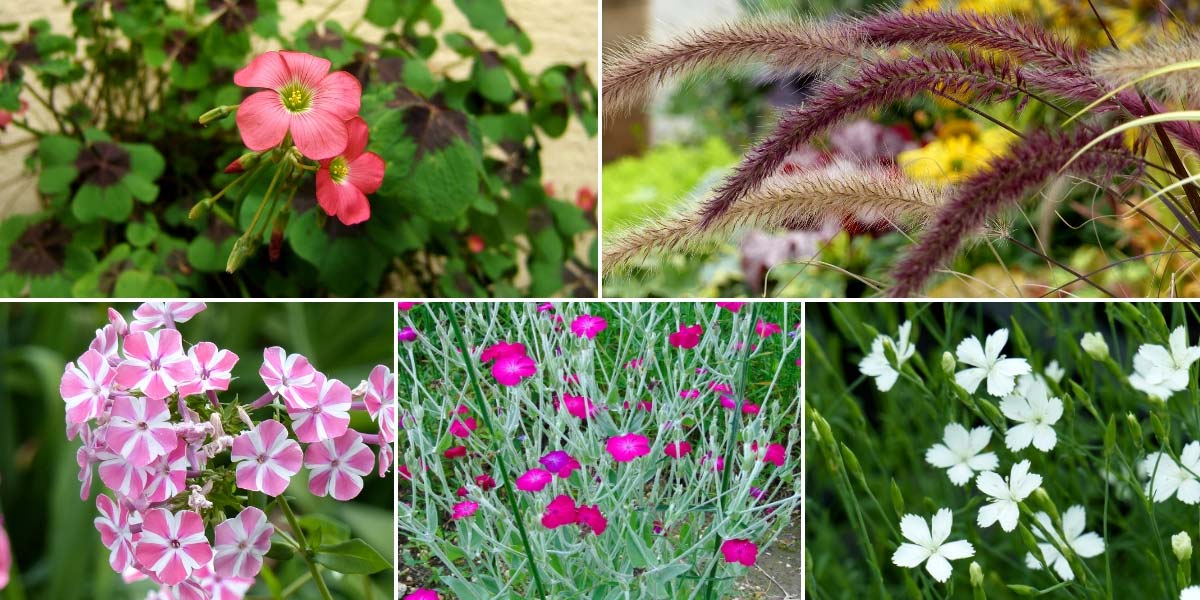
You can integrate Oxalis into a mixed bed with other colourful flowers and a few grasses. Oxalis tetraphylla (photo Wildfeuer), Pennisetum setaceum ‘Rubrum’, Phlox paniculata ‘Peppermint Twist’, Lychnis coronaria and Dianthus deltoides ‘Albiflorus’
Create a container composition or use a large pot, planting Oxalis with annual euphorbia ‘Diamond Frost’ (Euphorbia hypericifolia), which offers a superb airy flowering. Also consider hardy geraniums, nemesias, diascias, Laurentia, Lobelia erinus, Campanula muralis, hybrid verbenas, pansies… Favour colourful flowerings, and optionally add some plants with decorative foliage, such as ipomoeas, ivies and grasses.
You can create striking colour and contrast effects thanks to the superb purple foliage of Oxalis triangularis. You will just need to bring it indoors over winter. You can also choose Oxalis deppei, which offers attractive leaves, pale green at the edges and brown at the centre. Combine these Oxalis with other decorative, colourful foliage, such as heucheras, ophiopogon, Libertia, grasses, persicarias (Persicaria ‘Red Dragon’ or ‘Purple Fantasy’…), Sagina subulata, euphorbias… Also consider sedums, which provide diversity in foliage shapes and colours.
Indoors, Oxalis triangularis pairs very well with other exotic plants, possibly as hanging specimens. Place it alongside Ceropegia, Pilea peperomioides, Ficus pumila, ferns, banana plants…
→ Discover other ideas for pairing Oxalis in our advice sheet !
Did you know?
- Oxalis or clover?
Although oxalis can be confused with true clovers, these plants are easily distinguished by their flowering: oxalis produce star-shaped flowers, sometimes brightly coloured, whereas clover flowers are small, numerous, tubular, and gathered in globose spikes, often white or pink. Likewise, bulblets are usually visible when digging up oxalis.
- An edible and useful plant
Many species of oxalis have edible leaves with a tangy flavour and can substitute for sorrel. However, avoid eating large quantities because of the presence of oxalic acid, toxic in high doses.
Oxalis acetosella, for example, which grows wild in France, is edible and also has medicinal properties. It is nicknamed “Oxalis petite-oseille”, in reference to its slightly acidic taste.
Peruvian oca, meanwhile, is an oxalis whose swollen tubercle is eaten.
Useful resources
- Discover our range of Oxalis
- Discover our guide to choosing Oxalis
- Is Oxalis taking over your flowerbeds or pots? Our solutions to get rid of it
- Our advice sheet – How to create a beautiful perennial border?
- An article by Ingrid on our blog – Flower border: vary and mix shapes!
- Learn more about edible plants and leaves that can be cooked
Frequently asked questions
-
Leaves of my oxalis have powdery yellow-orange spots. What should I do?
Your plant is affected by rust, a fungal disease. Oxalis are fairly susceptible to it. It is an unsightly disease but not usually serious for the plant. You can remove affected leaves and spray a fungicide (sulphur, horsetail decoction...).
-
My oxalis leaves are turning brown and wilting.
If this happens after flowering, plant simply enters dormancy. Also note that Oxalis versicolor has an inverted cycle and enters dormancy in summer. Similarly, oxalis can lose their foliage during drought and produce leaves again as soon as watering resumes! That's their way of surviving dry spells.
- Subscribe!
- Contents
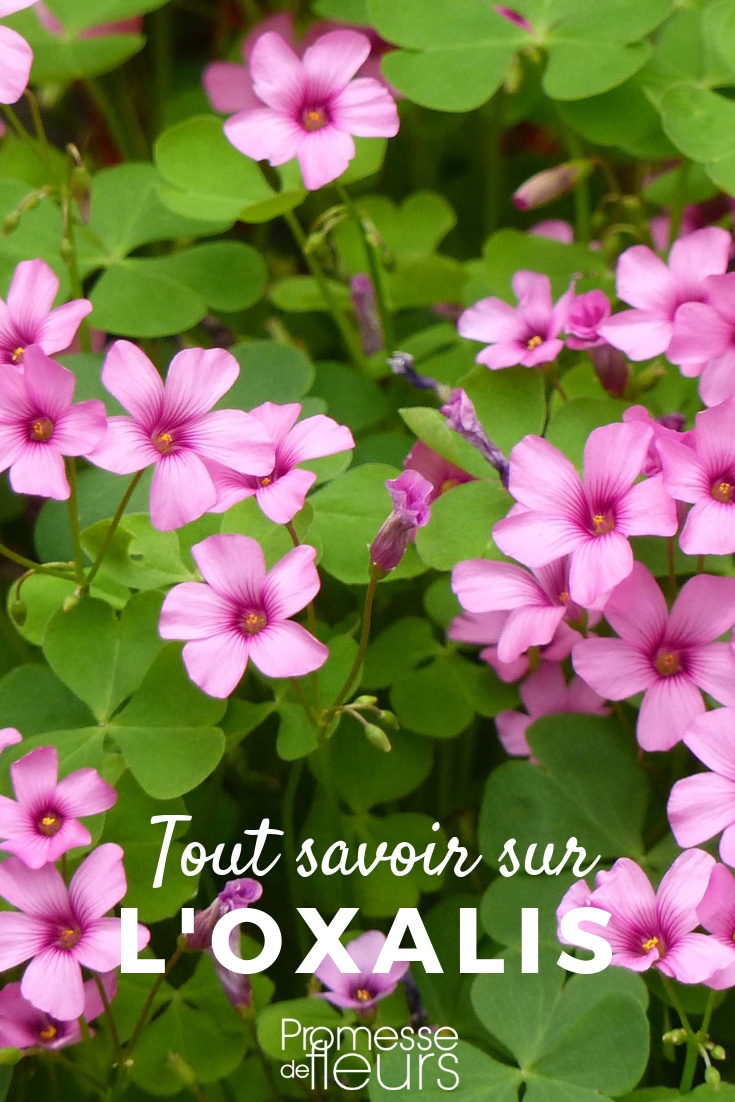


































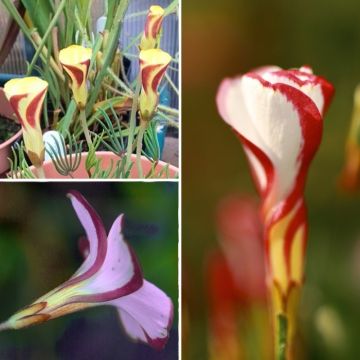
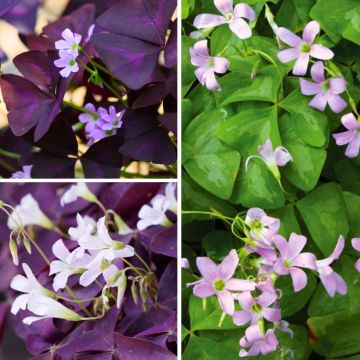

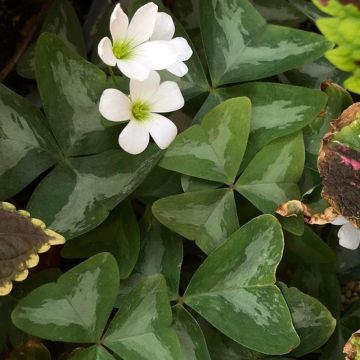

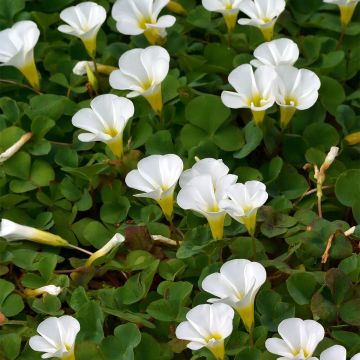

Comments